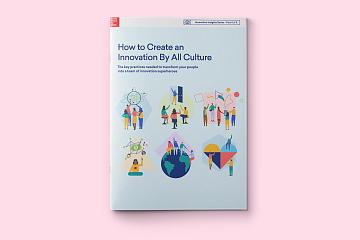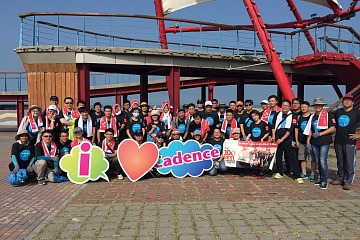Whether in business, non-profit, sports or entertainment, organizations are continuously asking the question, “How can we become more innovative?” Leaders have quickly recognized that their organization’s competitive position primarily depends on its capacity for constant transformation.
The late Peter Drucker asserted innovation’s invaluable role in business, stating, “Innovation by nature is risky, as is all economic activity. But defending what was done yesterday is far riskier than making tomorrow.”
In other words, firms must innovate to survive. Therefore, creating and sustaining a workplace culture that fosters innovation is imperative to an organization’s success.
Innovation Begins with a Mindset of Possibility
When you think of some of the most innovative companies, what often comes to mind are tech industry giants, such as Google and Amazon. However, innovation is not limited to any particular profile.
Just look at the likes of Stryker (manufacturing), Adobe (IT), Wegmans Food Markets (retail) and Texas Health Resources (health care)—all very different organizations that have all demonstrated an ability to reinvent themselves as time goes by.
Before exploring factors that contribute to an organization’s readiness for innovation from a cultural perspective, let’s start with defining what we mean by innovation.
What Innovation Means
More than an organization’s structure, age or other similar characteristics, innovation is the mindset of possibility that allows the seeds of change to take root.
Innovation can also be expressed as an “if/then" proposition.
“If” we can explore these markets, change these offerings, build these products, improve these processes etc., “then” our efforts will result in measurable gains for the organization.
Scott Noppe-Brandon of the Lincoln Institute positions innovation within the context of the ICI Continuum (Imagination, Creativity and Innovation). The process starts with imagination, which is a safe space to explore possibilities. Imagination then sparks creativity and creativity leads to innovation.
How Innovation Is Applied in the Workplace
While the concept of innovation may be simple enough to grasp, the process of driving innovation can be quite complex. Executives struggle every day with the question of how to make their companies more innovative.
One of the main factors that contributes to driving innovation is a workplace culture that emotionally connects people to the strategic direction of an organization and encourages a continuous flow of ideas that can support innovation efforts.
At Great Place To Work, we’ve surveyed millions of employees over the past two decades in producing the annual Fortune 100 Best Companies to Work For® list. Our data shows that some of the most innovative companies in the world have cultures that uniquely position them to drive creativity.
These cultures are built on high levels of trust. Employees have a secure connection to their leadership and to team members, as well as the ability to operate in an atmosphere that encourages risk-taking.
Key Aspects of Innovative Workplaces
1. A trust-based approach to idea exchange
Workplaces must have the right cultural enablers in place that support practices to explore growth opportunities.
A fundamental part of an innovative culture is a strong relationship between employees and their leaders, which our data shows is best measured through trust. High-trust relationships create opportunities for the sharing of ideas that help fuel innovation.
Leaders must intentionally develop a systematic, continuous and effective way of capturing employee ideas. To this end, embracing the right technological platforms for ideation can be an important part of an overall innovation strategy.
However, demonstrating leadership behaviors that encourage idea exchange can have an even greater impact.
"Driving innovation requires leaders to adopt the stance that within their employee population exists an unlimited reservoir of creativity." And one of the most important responsibilities a leader has is to tap into this reservoir.
This is a strength found in Fortune 100 Best Companies to Work For. When asked if “management genuinely seeks and responds to ideas,” 82% of employees respond that this is always or often the case.
Creating as many touchpoints as possible for idea exchange not only fosters greater meaning between leadership and employees, but also reinforces the organizational strategy and how individuals can contribute ideas that will support innovation.
2. Teamwork and social collaboration
Speed and agility also play an essential part in driving innovation. Organizations cannot afford overly long development times or slow decision making if they are to outpace the competition.
A company’s culture must enable cross-functional collaboration and minimize delays caused by traditional functional hand-offs. Innovative cultures are based on having a highly integrated organization that accelerates decision making and encourages active collaboration.
In evaluating cultures based on the degree of teamwork that employees experience, Great Place To Work research shows that within great cultures, the connection that people have to their colleagues and the sense of oneness is a key difference-maker.
Eighty-seven percent of employees at the Fortune 100 Best respond that, across the company, they can always or often count on people to cooperate.
3. Appetite for risk
With an emphasis on speed, another essential cultural enabler for innovation is having a greater appetite for risk. Risk-taking is not simply tolerated in high-trust cultures—it's celebrated.
Having an innovative culture will require adopting a more experimental approach to work. Within exploring ideas, prototyping and testing, there is an inherently higher failure rate.
When asked whether management “recognizes honest mistakes as a part of doing business,” 85% of employees at Fortune 100 Best Companies to Work For respond that this is often or almost always true.
Companies interested in positioning themselves for greater innovation can start by examining these three simple—but vitally important—areas:
- How engaged leaders are in seeking and responding to ideas
- The degree to which teamwork and social collaboration are fostered
- Whether there exists an appetite for risk.
By focusing on these aspects of your culture, driving innovation can become one of your company’s competitive advantages.
Innovation culture is the only way to stay ahead of change. For more insights on how to create a company culture that sparks, embraces and carries change, read our fresh Innovation by All Research.













